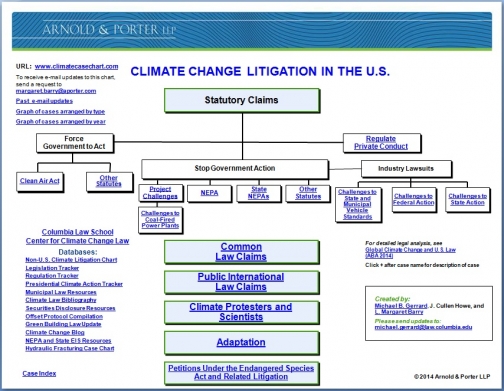by Michael Burger & Jessica Wentz
On Tuesday August 2 the Council on Environmental Quality (CEQ) released its much-anticipated Final Guidance to Federal Agencies on the Consideration of Greenhouse Gas Emissions and the Effects of Climate Change in NEPA Reviews. The final guidance is largely the same as the revised draft guidance issued in 2014: It directs federal agencies to account for the effects of a proposal on climate change, using greenhouse gas (GHG) emissions as a proxy for those effects, as well as the effects of climate change on the proposed action and its environmental impacts. There are, however, two notable changes: First, the final guidance no longer specifies a threshold for quantifying GHG emissions. Instead, it directs agencies to quantify emissions whenever the tools and data are available to do so. Second, the language calling for consideration of “upstream” and “downstream” emissions has been removed, and replaced with reference to the more technically precise term, “indirect effects.” Importantly, the guidance states that the reasonably foreseeable indirect effects that should be accounted for in NEPA documents would include what are, in essence, downstream emissions – for example, emissions from the end-use of coal that is mined as a result of a federal action. More on this below.
One important aspect of this final guidance is that it will provide certainty to federal agencies about how to address considerations related to climate change in their NEPA reviews. This will likely prompt many agencies to adopt more detailed, agency-specific guidance that is tailored to the types of actions that they frequently review. For example, several agencies have been waiting for the final CEQ guidance in order to adopt internal guidance on accounting for the effects of climate change on land and resource management actions.
The final CEQ guidance comes after a lengthy process of public engagement and interagency consultation. In 2008 several environmental groups formally petitioned CEQ to issue such guidance. (One of them, the Natural Resources Defense Council, was represented by Michael Gerrard, the Sabin Center’s Faculty Director.) CEQ issued two iterations of the guidance – an initial draft in 2010 and a revised draft in 2014 – and the guidance has evolved considerably with each new version. For example, the initial draft did not address whether agencies should account for the effects of federal land and resource management decisions on carbon sequestration, whereas the 2014 draft and the final version direct agencies to consider such effects and cite tools that can be used to perform this analysis.
The 2014 draft and final version also contain significantly more information about how to account for the effects of climate change on a proposed action and its environmental impacts, as compared with the 2010 draft. The final guidance states that “a NEPA review should consider an action in the context of the future state of the environment,” taking into account the effects of climate change, in order to accurately characterize the environmental consequences of the action. It also recognizes that climate change adaptation and resilience are important considerations for many federal actions. The guidance is therefore consistent with our previous analysis of this topic and model protocols we have developed for addressing the effects of climate change on projects undergoing environmental review.
As noted above, there are two significant changes in the final guidance. The first change – the removal of the quantification threshold – could have a major effect on federal agency practice. In both the 2010 and 2014 drafts, CEQ had recommended that agencies quantify GHG emissions when the proposal’s total emissions (measured in CO2e) surpass 25,000 tons per year (tpy). Although the guidance was still in draft form, federal agencies began citing this requirement in environmental review documents – often as a justification for not quantifying emissions from a particular project (this was one key finding from the Sabin Center’s latest federal EIS survey). Many commentators were rightfully concerned that the 25,000 tpy threshold was too high. One coalition of environmental groups noted that 25,000 tpy of CO2e would generate estimated global damages in the tens of millions of dollars over a twenty year proposed lifespan, based on the damage estimates set forth in the federal Social Cost of Carbon (SCC). CEQ removed the quantification threshold and now recommends that agencies quantify direct and indirect GHG emissions whenever the tools, methodologies, and data are available to do so.
The second change – the replacement of language calling for consideration of “upstream” and “downstream” emissions with reference to “indirect effects” – was likely driven by concerns from some stakeholders about the lack of clarity as to just how far upstream or downstream the agency should look when conducting a NEPA review. The 2014 draft guidance specified that:
“[E]missions from activities that have a reasonably close causal relationship to the Federal action, such as those that may occur as a predicate for the agency action (often referred to as upstream emissions) and as a consequence of the agency action (often referred to as downstream emissions) should be accounted for in the NEPA analysis.”
This raises questions about the scope of the emissions analysis for many projects. For example, if a federal agency is constructing a facility, does it need to consider the emissions that are generated from the manufacturing and transportation of all of the construction materials? The 2014 draft didn’t clarify exactly how this analysis should be conducted in the context of most projects, although it did note that, for an open pit mine, the NEPA review could encompass “reasonably foreseeable effects of various components of the mining process, such as clearing land for the extraction, building access roads, transporting the extracted resource, refining or processing the resource, and using the resource.”
The removal of this language from the final guidance does not mean that agencies can simply ignore all “upstream” or “downstream” emissions in their NEPA reviews. Agencies must still consider reasonably foreseeable indirect effects, and these may include upstream and downstream emissions. This is certainly true for fossil fuel-related approvals, where there is a clear causal connection between each phase of the fossil fuel supply chain (production, transportation, processing, and end-use) and the emissions from these activities can be estimated with existing tools and data. Indeed, the guidance explicitly notes that the indirect effects of a Federal lease sale of coal for energy production would include emissions from the combustion of the coal (see FN 42). Moreover, the guidance directs agencies to a study of lifecycle GHG emissions from coal and natural gas as an example of the type of resource that should be used to evaluate indirect emissions (see FN 43).
Finally, regarding the scope of connected actions that should be reviewed together, the guidance echoes the 2014 draft’s language on upstream and downstream emissions, noting that: “activities that have a reasonably close causal relationship to the Federal action, such as those that may occur as a predicate for a proposed agency action or as a consequence of a proposed agency action, should be accounted for in the NEPA analysis.” For example, “NEPA reviews for proposed resource extraction and development projects typically include the reasonably foreseeable effects of various phases in the process, such as clearing land for the project, building access roads, extraction, transport, refining, processing, using the resource, disassembly, disposal, and reclamation.”
Thus, the final guidance supports the proposition that we advance in a forthcoming law review article: upstream and downstream emissions do fall within the scope of the NEPA review for fossil fuel-related projects.
Apart from these changes, the final guidance is largely consistent with the 2014 draft version. A thorough analysis of the 2014 draft guidance is available here.




